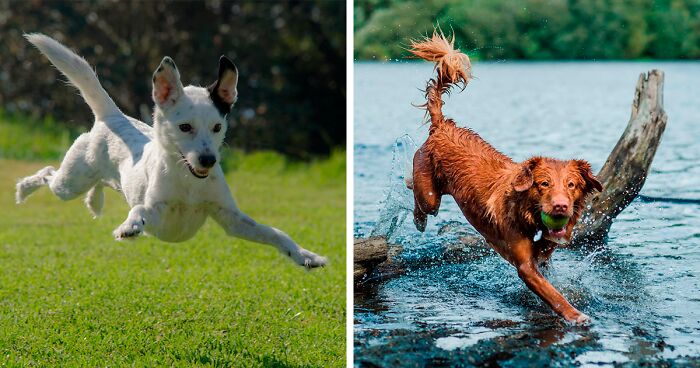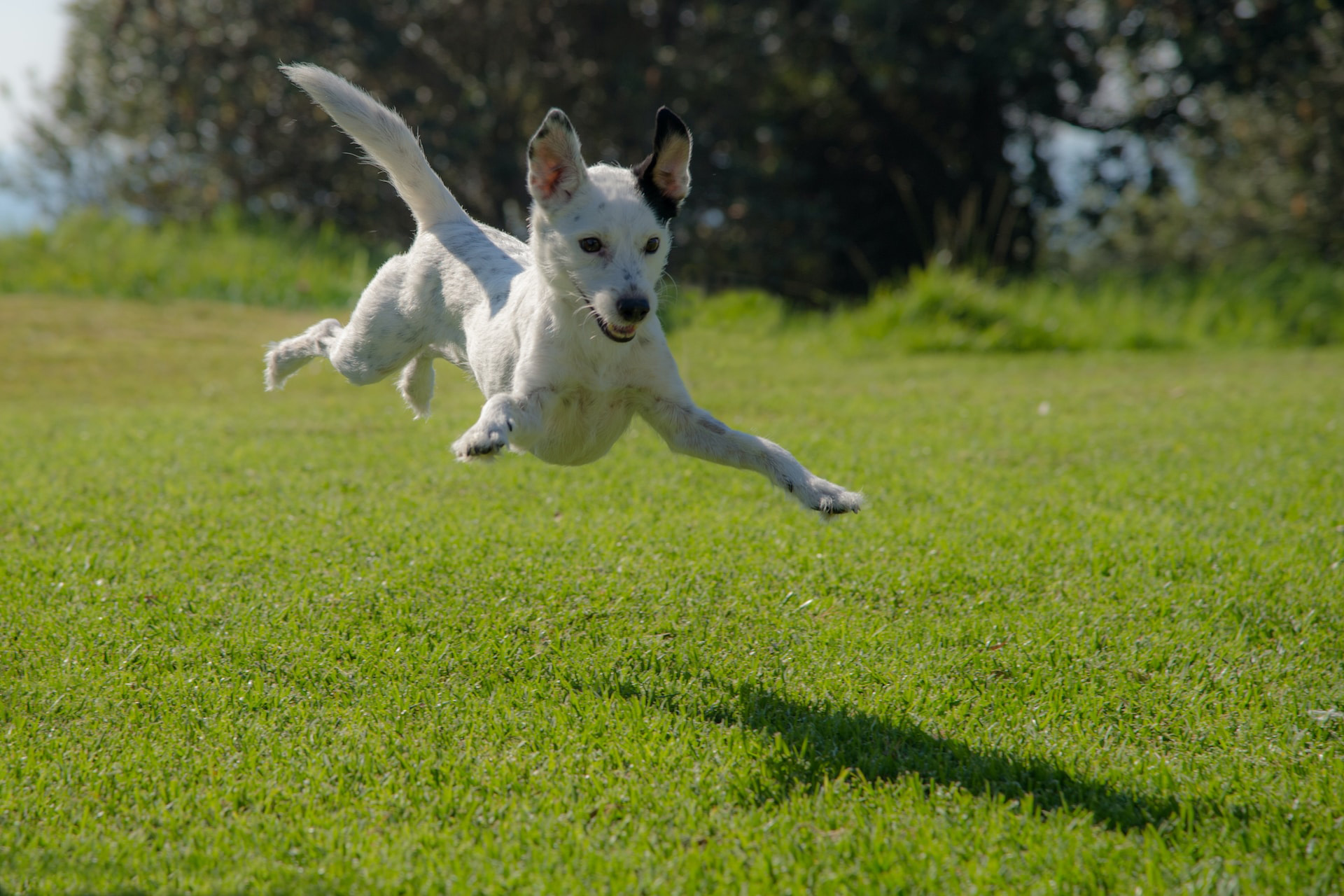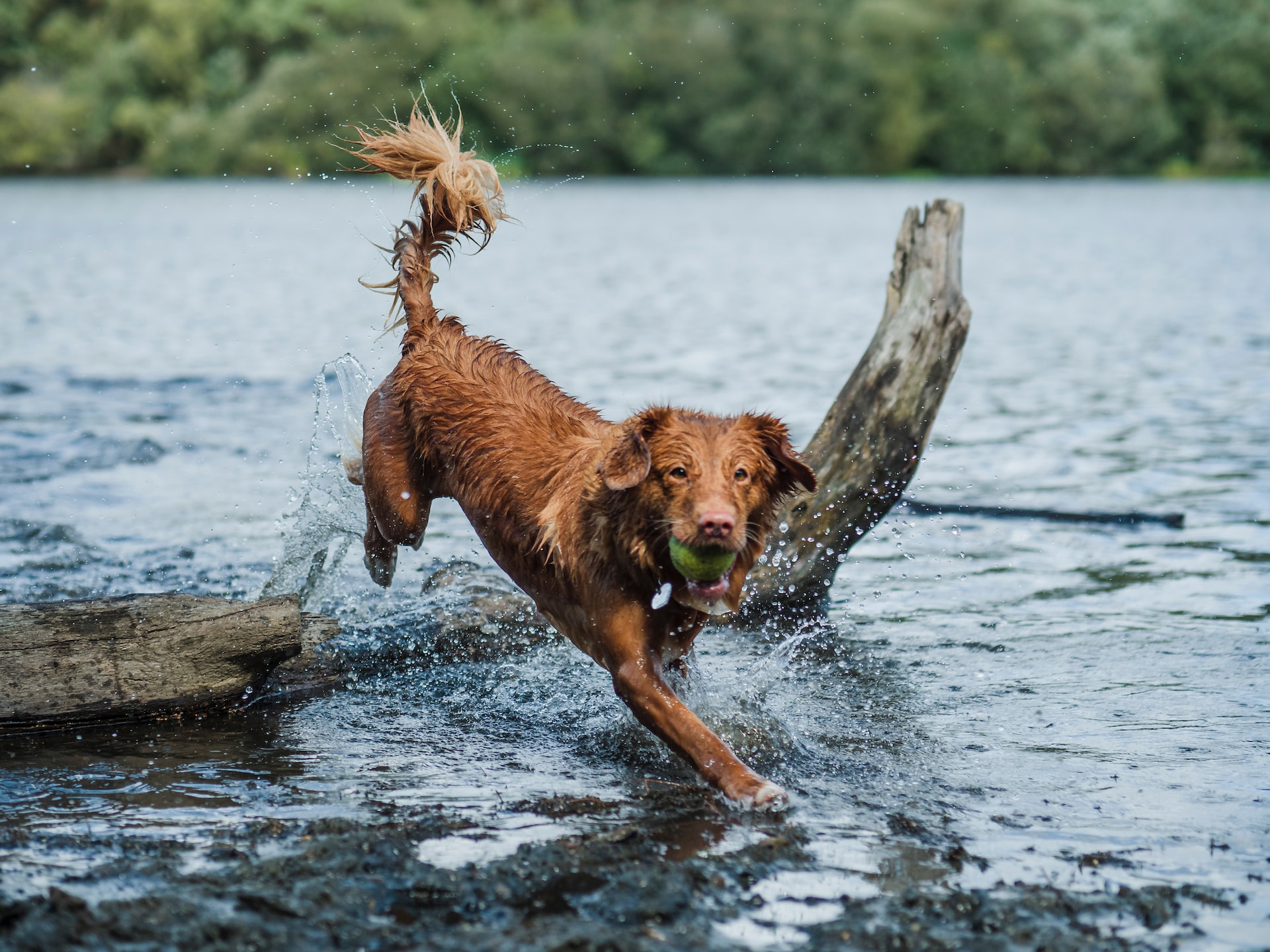Are you struggling to figure out how to settle down with your high-energy dog? Many dog owners face the challenge of managing a hyperactive pup, often feeling overwhelmed and unsure of what to do about it.
But what if there were effective ways to channel this boundless energy into something positive? Is it really possible to calm down your hyper puppy?
- Calming a hyper dog requires exercise, diet, and a calm environment.
- Mental stimulation is as tiring for dogs as physical exercise.
- Professional help may be needed for persistent hyperactive dogs.
Calming a hyper dog involves a blend of understanding their breed characteristics, recognizing signs of overstimulation, and employing strategies like routine exercise, a calm environment, and thinking about their diet. Each of these plays an important part in making life with your energetic dog more harmonious.
But there’s more to it than just wearing them out. Keep reading to find out all about how to manage a dog’s hyperactivity. This includes understanding why some dogs are more active than others. And useful tips on making a quiet space for your pet.
The information provided herein is for informational purposes only. Please refer to our disclaimer for more details..
- 5 Tips To Calm Down a Hyper Dog
- The Most Hyper Dog Breeds
- Understanding Hyperactivity in Dogs Through Their Life Stages
- Why Is My Dog So Hyper?
- Is Hyperactivity Harmful to Dogs?
- What Does It Look Like When a Dog Is Overstimulated?
- How Do You Treat Sensory Overload in Dogs?
- What to Do When Your Dog Won’t Calm Down
- Wrapping Up
5 Tips To Calm Down a Hyper Dog
There are a wealth of strategies designed to turn your hyperactive dog into a calmer and happier companion. Let’s explore some transformative tips and make life with your energetic dog friend a lot more peaceful.
1. Regular Exercise and Playtime
You might already know, but it bears repeating: regular exercise is crucial for a dog’s well-being, especially those with energy to burn. Think of it as their natural outlet. Here’s the twist though – it’s not just about the quantity, but also the quality of exercise. Let’s talk specifics:
- Outdoor Adventures: Activities like walks or fetch are great, but remember, the amount of exercise depends on the breed. For instance, adult sporting or herding dogs might need up to 90 minutes of exercise daily. The fresh air and new settings also provide much-needed mental stimulation.
- Interactive Dog Sport: Engage in physical exercise that involves both of you. Tug-of-war, hide-and-seek with dog treats, or obstacle courses in your backyard can do wonders. It’s a workout for their body and brain.
- Doggie Playdates: Getting your dog into playdates is fantastic for expending energy and socializing, but they shouldn’t be seen as a ‘quick fix’. Remember, consistent and varied activities are key to managing hyperactivity effectively.
2. Training and Mental Stimulation
Here’s something that might surprise you: mental exercise can tire a dog out just as much as physical activity, if not more. Dog training sessions are not just about obedience, they’re about engagement. Consider these approaches:
- Daily Training Sessions: Incorporate short but regular training sessions. Teach new tricks or reinforce old ones. This not only relaxes them but also strengthens your bond.
- Puzzle Toys: Ever seen a dog with a puzzle toy? It’s pure concentration. These toys challenge their brain, making them focus and, ultimately, helping to drain that hyper energy.
- Sniffing Games: Dogs experience the world largely through their noses. Hide treats around the house and train your dog to sniff them out. Nose works are a simple yet effective way to engage their minds deeply.
- Trick Training & “Touch” Cue: Training your puppy with new tricks or the “touch” cue. This not only provides mental stimulation but also enhances their learning and responsiveness.
- Impulse control: Teach your dog impulse control methods, such as “leave it” or “stay,” to help your dog learn to resist immediate temptations and impulses, promoting self-discipline and better behavior in various situations. For example, teaching your dog to “leave it” when tempted by a treat on the ground can prevent them from snatching it impulsively.
3. Creating a Calm Environment
A calm dog starts with a peaceful environment. Think of your home as a sanctuary, a place where peace reigns. This doesn’t mean a silent house. But a space where your dog feels safe and relaxed. Here are some ideas to create such an environment:
- Designate a ‘Chill Zone’: Set up a cozy area for your dog with their favorite bed or blanket. And, this will be their go-to spot for winding down.
- Routine is Key: Dogs thrive on routine. Morning potty break, breakfast, training session, crate and toy time, walk, play session, rest time, dinner, and bedtime provide a sense of security and reduce anxiety. Remember, consistency in the routine eases stress for both your dog and you.
- Controlled Playtime: Yes, playtime is good. But it’s also important to teach your dog when it’s time to settle down. You can also use gentle commands to signal the end of playtime.
4. Dietary Considerations
What goes into your dog’s stomach can significantly affect their behavior. And a diet for example that’s high in sugar or carbohydrates, might contribute to their energetic behavior. Let’s find out how you can address these issues:
- Balanced Diet: It’s essential to choose a dog food that aligns with your dog’s size, lifestyle, and activity level. Commercial dog foods are formulated according to your dog’s daily calorie needs. But you should always consult your vet for guidance on selecting the right food based on the factors mentioned above.
- Impact of Sugary Foods: Avoid feeding your dog sugary foods such as sugar supplements like Nutrical, Karo syrup, or dog-friendly ice creams because these can spike their glucose levels and cause short-term hyperactivity. That increased energy from these foods will wear off quickly, but it’s best to avoid them.
- Calming Treats: Treats containing ingredients like valerian root, L-tryptophan, and melatonin can help reduce hyperactivities. However, they might not work for every dog. And it’s important to consult your vet before introducing them.
- Regular Feeding Schedule: Like routine – giving your dog a consistent feeding schedule can help stabilize your dog’s energy levels.
5. Professional Help and Therapies
Sometimes, even after your best efforts, you might need professional help, and that’s okay. Seeking advice from a vet or a dog behaviorist can provide you with tailored strategies. Specific to your unique situation. Here are some scenarios that require help for your dog:
- Persistent Hyperactivity: If your dog remains energetic despite your best efforts, it could be a sign of an underlying health issue.
- Behavioral Therapies: A professional can offer therapies such as desensitization or counterconditioning. These can be highly effective for certain dog behaviors.
- Medical Intervention: For extreme medical conditions. That is difficult to manage. Your vet might suggest calming treats or prescription medications such as trazodone. Remember, medication should be a last resort and always under a vet’s guidance.
The Most Hyper Dog Breeds
Some dog breeds are naturally more energetic than others such as:
- Border Collies
- Australian Shepherds
- German Shepherds
- Golden Retrievers
- Staffordshire Bull Terriers
- Smooth Collies
- Cairn Terriers
- Jack Russell Terriers
These breeds are well-known for their excess energy.
These breeds were developed for work. That requires constant movement and quick thinking, which translates into their day-to-day behavior.
On the flip side, breeds like Bulldogs and Basset Hounds tend to be more laid-back. Knowing your dog’s breed traits can provide valuable insights into their behavior. And help you tailor your approach to meet their specific needs.
Understanding Hyperactivity in Dogs Through Their Life Stages
Hyperactivity can vary depending on the life stage of a dog. Puppies and adolescent dogs often find it challenging to focus and may appear energetic because they are in their developmental stages. This is a natural phase for them.
Gender and Breed Considerations in Hyperactivity
While young puppies are often perceived as more active. But this isn’t a set rule. Both male and female dogs of any breed can exhibit this behavior. However, dogs belonging to working, sporting, or herding breeds typically have higher energy levels. And might be more challenging for pet parents.
Age and Calming Down
Excited dogs may start to show less activity around 2 years of age. But, for many, real calming behaviors occur around 5 to 6 years old. For breeds not classified as high-energy. Their behavior usually subsides by 1 and a half years old.
Why Is My Dog So Hyper?
Have you ever wondered why your furry friend seems to have a lot of energy, bouncing off the walls at all hours? Understanding the cause of your dog’s hyperactivity is key. Here are some common reasons:
- Excitement: Some dogs naturally get excited very easily, leading to behaviors like zoomies—officially called frenetic random activity periods (FRAPs). This is a natural way for dogs to release tension and excitement. If this happens frequently, consulting a vet or dog behaviorist may be helpful.
- Boredom: Dogs who are alone for long periods or don’t get enough exercise tend to exhibit hyper behavior. To counter this, consider arranging a dog sitter and increasing both physical and mental activities. Engaging with your dog and providing enough mental and physical stimulation is crucial.
- Anxiety: Anxiety can make dogs restless. If your dog shows other signs of anxiety along with restlessness, using dog-appeasing pheromones, often recommended for separation anxiety, might help.
Is Hyperactivity Harmful to Dogs?
It can impact a dog’s physical health. Just like humans, dogs can experience stress and anxiety from overstimulation and excessive arousal. Which isn’t healthy if continuous. Particularly for younger dogs. Too much activity might stress their bones and joints.
- Risks in Hot Weather: During summer, increased activity poses a higher risk for brachycephalic breeds such as Boxer, and Bulldog. Due to their susceptibility to overheating. Recognizing signs of overheating, like panting and bright red gums, is important for timely treatment.
- Cooling Off Activities: On hot days, engaging in water-based naturally calming activities like dog swim classes or lake swims can be an effective way to manage a dog’s hyper behavior. It will keep your dog cool.
What Does It Look Like When a Dog Is Overstimulated?
Recognizing an overstimulated dog is a vital skill for any dog owner because overstimulation goes beyond regular excitement. And, can lead to stress and behavioral issues if not managed properly. Common signs include:
1. Excessive Barking or Whining: When dogs feel overwhelmed it is their way of expressing frustration or anxiety. Unlike regular barking, this tends to be more frantic and persistent.
2. Pacing and Restlessness: If your dog is constantly moving, pacing back and forth, or seems unable to find a comfortable spot to rest. This could be a sign of sensory overload. An overstimulated dog might find it hard to settle down
3. Jumping and Nipping: These behaviors can be an expression of a dog’s inability to manage their excitement or sensory input and also it’s their way of trying to cope with the overwhelming stimuli around them.
How Do You Treat Sensory Overload in Dogs?
When it comes to sensory overload in dogs, prevention is always better than cure. If a dog approaches you with excitement requires a proactive approach in dealing. Some ways to calm and prevent overstimulation include:
1. Creating a Relax Environment: Minimizing noise and activity around your dog as a quiet, peaceful home environment can significantly help dogs prone to sensory overload. This includes turning down loud music, avoiding sudden loud noises, and creating a safe spot. A place where the dog can retreat.
2. Consistent Routine and Structure: Establishing a predictable routine helps provide stability. Such as regular feeding times, exercise schedules, and a consistent sleep routine can greatly reduce stress in anxious dogs.
3. Controlled Exposure to Stimuli:Introduce your dog to new stimuli gradually and in controlled settings for example slowly introducing them to new environments like dog parks, people, or other animals. And allowing them to adapt without becoming overwhelmed.
4. Identifying and Avoiding Triggers: Understand what specific situations or environments make your dog overstimulated, if crowded places, loud noises, or certain activities tend to overwhelm your dog, try to avoid these as much as possible. And when you do expose them. Do it in a controlled and reassuring way.
What to Do When Your Dog Won’t Calm Down
Facing a dog that won’t relax down, requires both immediate and long-term strategies in place. Here we will discuss two approaches to help your dog relax and regain composure:
1. Immediate Steps to Calm Your Dog
- Remove from Stimulating Environment: The first step is to take them away from the environment causing this reaction – overexcited or stressed. This could mean moving them to a quieter room, or away from a crowd or noisy area.
- Provide a Safe, Quiet Space: This could be a crate lined with their favorite blanket, a quiet corner of the house, or any area where they feel secure and undisturbed. The goal is to provide an environment that’s free from noise and distractions.
- Use Calming Techniques: Softly speaking to your dog in a soothing voice can help calm them down. Also, gentle petting or brushing can be comforting. For some dogs, using products like calming sprays, diffusers, or a weighted anxiety blanket can be beneficial.
2. Long-Term Strategies for a Calmer Dog
If you’ve tried various strategies and your dog is still consistently hyper. Then it might be time to consult a veterinarian or a canine behaviorist. They can provide more targeted advice. And, if necessary, discuss the possibility of medication or other interventions.
Wrapping Up
Dealing with active dogs can be challenging. But with the right strategies, it’s manageable. It’s important to understand the reasons behind their energy, recognize signs of overstimulation, and know how to create a balanced environment can help a lot.
Remember what works for one might not work for another as every dog is unique. Every action you take, like making a quiet area or doing structured playtime, helps make life better and calmer for your furry buddy.
Keep this in mind! When you implement these strategies – patience, and consistency are the key here. Your dog isn’t just an animal you own, they’re a part of your family. Growing this relationship is a journey that’s full of learning and affection.
539views
Share on Facebook
 Dark Mode
Dark Mode 

 No fees, cancel anytime
No fees, cancel anytime 







 Image credits:
Image credits:  Image credits:
Image credits: 










































-1
0